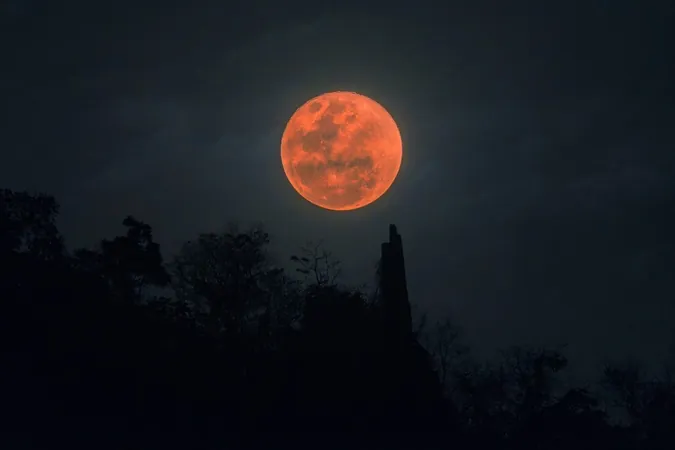
Mark Your Calendars! A Stunning Blood Moon Eclipse is Coming in March 2025 - Here's How to Catch It!
2025-01-03
Author: Emma
Are you ready for one of the most breathtaking celestial events of 2025? Coming this March, a total lunar eclipse will be visible across North America, South America, and parts of Europe. Though the year won’t have a total solar eclipse, the upcoming blood moon will certainly make up for it!
On the nights of March 13–14, 2025, the full Moon will journey through Earth's shadow, creating a mesmerizing lunar spectacle where its surface will take on a striking reddish hue, affectionately known as a 'blood moon'. This magnificent phenomenon will last over an hour, offering a splendid display for skywatchers.
What Can You Expect?
Prepare yourself for the first total lunar eclipse since November 8, 2022. This will not only be your first chance to see a total lunar eclipse in 2025, but also a phenomenal two-part event, as a second total lunar eclipse is set for September 7–8, 2025. However, North American observers will miss out on the second eclipse, but luck is on the side of viewers in the UK, who will catch a glimpse of it during moonrise on the 7th.
The Science Behind the Magic
A total lunar eclipse occurs when the Earth positions itself directly between the Sun and a full Moon, causing the Earth's shadow to envelop the lunar surface. As sunlight filters through our atmosphere and scatters—much like what happens during vibrant sunsets—the Moon bathes in a captivating shades of red and orange.
Phases of the Eclipse
The lunar eclipse event comprises five distinct phases, each lasting around an hour:
1. Penumbral Lunar Eclipse: The Moon enters the Earth’s penumbra, dimming slightly.
2. Partial Lunar Eclipse: The Moon begins to enter the Earth's umbra and starts taking on its reddish hue.
3. Total Lunar Eclipse (Totality): The Moon is fully engulfed in the umbra, displaying the brilliant blood red color.
4. Partial Lunar Eclipse: The Moon starts to exit the umbra and begins losing its reddish coloring.
5. Penumbral Lunar Eclipse: The Moon leaves the penumbra, regaining its brightness.
When to Watch
For North America, the total lunar eclipse will be visible throughout the night, providing ample opportunity to enjoy the spectacle. Here’s the timeline for EST:
- Penumbral eclipse begins: 11:57 p.m. (March 13)
- Partial eclipse begins: 1:09 a.m. (March 14)
- Totality begins: 2:26 a.m.
- Totality ends: 3:31 a.m.
- Partial eclipse ends: 4:47 a.m.
- Penumbral eclipse ends: 6:00 a.m.
In Europe, particularly the UK, observers will catch the initial phases before moonset. The key phases to watch are:
- Penumbral eclipse begins: 3:57 a.m. GMT (March 14)
- Partial eclipse begins: 5:09 a.m. GMT
- Moonset at 6:22 a.m. GMT
Watch Safely!
Unlike solar eclipses, total lunar eclipses are safe to observe with the naked eye—no special glasses are required. The dimmed light of the eclipsed Moon offers a more comfortable viewing experience compared to a normal full Moon.
The Cosmic Additions
During this event, viewers will also have the opportunity to observe the bright planet Mars nearby, enhancing the visual feast. Plus, keep an eye on the aurora forecasts; the Sun is currently in a phase of heightened activity, possibly granting us spectacular displays of the Northern Lights during the eclipse.
More Celestial Wonders
But the lunar excitement doesn’t end there! Just two weeks later, a partial solar eclipse will occur on March 29, 2025, visible in parts of northeastern North America, Europe, and the Arctic. Be prepared to witness a mesmerizing sunrise where the Moon will cover up to 86% of the Sun!
Don't miss out on this celestial showcase—mark your calendars, prepare your binoculars, and get ready to look up at the sky on the enchanting night of March 13-14, 2025!









 Brasil (PT)
Brasil (PT)
 Canada (EN)
Canada (EN)
 Chile (ES)
Chile (ES)
 Česko (CS)
Česko (CS)
 대한민국 (KO)
대한민국 (KO)
 España (ES)
España (ES)
 France (FR)
France (FR)
 Hong Kong (EN)
Hong Kong (EN)
 Italia (IT)
Italia (IT)
 日本 (JA)
日本 (JA)
 Magyarország (HU)
Magyarország (HU)
 Norge (NO)
Norge (NO)
 Polska (PL)
Polska (PL)
 Schweiz (DE)
Schweiz (DE)
 Singapore (EN)
Singapore (EN)
 Sverige (SV)
Sverige (SV)
 Suomi (FI)
Suomi (FI)
 Türkiye (TR)
Türkiye (TR)
 الإمارات العربية المتحدة (AR)
الإمارات العربية المتحدة (AR)